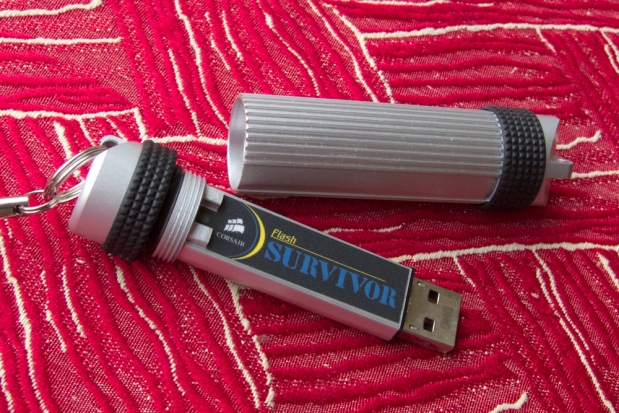
the Corsair Survivor is a near-bulletproof USB drive. Perfect for backups!
As some of you will know, I'm currently travelling around the world for a few months, and I'm writing this from a rather lovely balcony outside our hotel in Hoi An, Viet Nam.
As a traveller, I'm worried about many things; I've had a ton of vaccinations, I'm on malaria medication, and you're living with a healthy suspicion of the food you're eating (no problems so far; knock on wood). There is one thing that is a bigger worry to me than any of this, however: Losing my data.
I've written about my backup routines when I'm back home in the past, but when you're on the road, you're living with all sorts of other challenges. My internet connection is slow and flakey at best (non-existent at worst), and Vietnam's government has taken to blocking various websites (including blocking Facebook). Given Egypt's most recent insanity (blocking all internet access for the whole country) and the ongoing shenanigans of China's government... Basically, it's not safe to assume that you'll be able to take backups in the cloud whilst travelling.
So, what else is a poor traveller to do? As a writer and photographer, I cannot risk losing all the photos I've taken, and the work on the books I'm currently writing on.
Offsite backups, on-site
My solution goes a little bit like this: Every day, I take a back-up of my stuff, using Apple OS X's built-in backup solution, Time Machine. I take this back-up onto a fantastic little drive, the Iomega eGo Helium. It's a tiny, palm-sized, USB-powered 1TB harddrive, that cost a paltry $130 from Amazon - certainly one of the better investments I've made.
Because of the way Time Machine works, I know I'll have a completely up-do-date copy of my entire system, my software, my writings, pictures, music, and all my financial information (even though I keep my finances and accounts in the cloud using Xero anyway, it's good to know that I have a separate backup, too) on that little big hard drive.
Whenever I leave the hotel, I take the hard drive with me: It lives in my day-pack, which I 'lock' (i.e. use the waist strap to fasten it) to the table, chair, or motorbike wherever I go. This means that my back-up drive is probably safe. It'd better be: I also keep (some of) my travel money and my passport in that backpack. Meanwhile, back at the hotel, I have all my data on my laptop, either hidden in the hotel room, or locked in a hotel safe, if there is one.
The idea is this: If I lose the backup drive, I can buy a new one, and go back to keeping backups. If I lose my computer (i.e. it gets stolen, or it breaks in one way or another), I have to find an Apple store and buy myself a new one. It'd be expensive, but that's what travel insurance is for: And all my data would still be safe on my laptop.
What about when you are with your laptop?
There are times, obviously, where me, the backup drive, and the laptop will necessarily have to be in the same place. When I'm flying, for example, I make sure that the hard drive is in my checked luggage, whilst my laptop is with me.
When I'm sleeping, the Iomega drive lives under my pillow - next to my passport and a spare credit card. The idea is that even if somehow a thief manages to steal every single other thing I own, I still have my data, a way of getting out of the country, and a credit card to help me solve any bad problems.
What about the really important files?
I have a small subset of files that are so important that if I lose them, I'm buggered. It includes the manuscripts to my unpublished books, copies of my passport and credit cards, all that sort of fun stuff.
Those files are about 2GB in size in total, and I back them up religiously: They are automatically backed up to DropBox, an online backup service, whenever I do have an internet connection. In addition, I back it up to a Corsair Survivor, a shock-proof, water-proof, and extremely rugged USB thumb drive. It lives in my pocket, and looks inconspicuous enough that I think I should be able to hang on to it even if I were robbed (knock on wood) in the street.
Finally, I e-mail manuscripts in progress to my Google Mail account whenever I have an internet connection.
Dude, are you paranoid or something?
Probably. But I think this is one of the situations where the phrase "Better safe than sorry" comes in ringing true.
I decided to be paranoid after doing the worst-case-scenario maths: If I were to lose my data and my laptop at the same time, the only way I can continue working and get the books done before deadline, is to get on a plane back to the UK, get my backups from storage, buy a new laptop, restore it all, and head back to Vietnam. It would cost me thousands and thousands of dollars - and probably cost me at least of week of time.
Put simply; if the worst were to happen, I probably wouldn't be able to afford to continue my nomadic lifestyle - which I'm rather enjoying at the moment, and would like to continue for a while!
This article was first published on Small Steps, my travel blog.
Do you enjoy a smattering of random photography links? Well, squire, I welcome thee to join me on Twitter -
© Kamps Consulting Ltd. This article is licenced for use on Pixiq only. Please do not reproduce wholly or in part without a license. More info.










